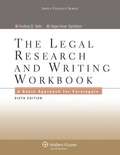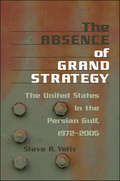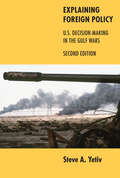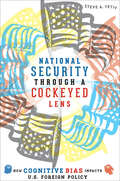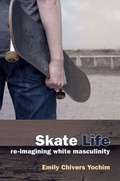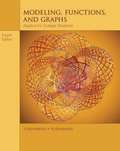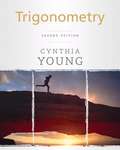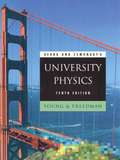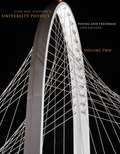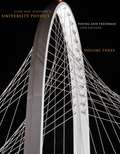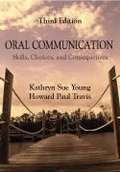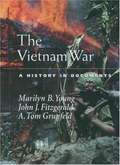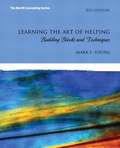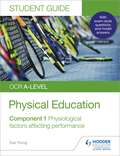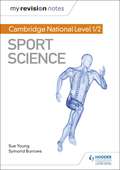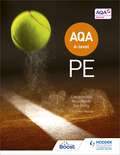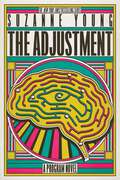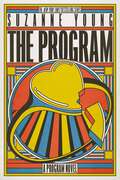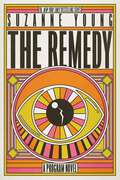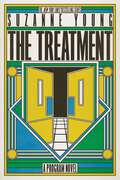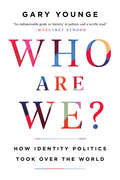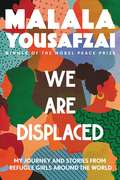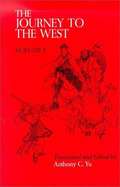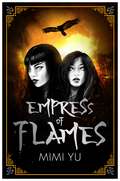- Table View
- List View
The Legal Research and Writing Workbook: A Basic Approach for Paralegals (6th Edition)
by Andrea B. Yelin Hope Viner SambornProviding effective research tools, practical strategies and an efficient procedure for researching the law with both traditional and electronic sources, this textbook on research and writing makes every step of the process accessible to paralegal students. Step-by-step instruction leads students through each stage of activity, from prewriting to revising, and covers the IRAC method, legal memoranda, letters, and more.
The Absence of Grand Strategy: The United States in the Persian Gulf, 1972–2005
by Steve A. YetivGreat powers and grand strategies. It is easy to assume that the most powerful nations pursue and employ consistent, cohesive, and decisive policies in trying to promote their interests in regions of the world. Popular theory emphasizes two such grand strategies that great powers may pursue: balance of power policy or hegemonic domination. But, as Steve A. Yetiv contends, things may not always be that cut and dried. Analyzing the evolution of the United States' foreign policy in the Persian Gulf from 1972 to 2005, Yetiv offers a provocative and panoramic view of American strategies in a region critical to the functioning of the entire global economy. Ten cases—from the policies of the Nixon administration to George W. Bush's war in Iraq—reveal shifting, improvised, and reactive policies that were responses to unanticipated and unpredictable events and threats. In fact, the distinguishing feature of the U.S. experience in the Gulf has been the absence of grand strategy.Yetiv introduces the concept of "reactive engagement" as an alternative approach to understanding the behavior of great powers in unstable regions. At a time when the effects of U.S. foreign policy are rippling across the globe, The Absence of Grand Strategy offers key insight into the nature and evolution of American foreign policy in the Gulf.
Explaining Foreign Policy: U.S. Decision-Making in the Gulf Wars
by Steve A. YetivSteve A. Yetiv has developed an interdisciplinary, integrated approach to studying foreign policy decisions, which he applies here to understand better how and why the United States went to war in the Persian Gulf in 1991 and 2003. Yetiv’s innovative method employs the rational actor, cognitive, domestic politics, groupthink, and bureaucratic politics models to explain the foreign policy behavior of governments. Drawing on the widest set of primary sources to date—including a trove of recently declassified documents—and on interviews with key actors, he applies these models to illuminate the decision-making process in the two Gulf Wars and to develop theoretical notions about foreign policy. What Yetiv discovers, in addition to empirical evidence about the Persian Gulf and Iraq wars, is that no one approach provides the best explanation, but when all five are used, a fuller and more complete understanding emerges.Thoroughly updated with a new preface and a chapter on the 2003 Iraq War, Explaining Foreign Policy, already widely used in courses, will continue to be of interest to students and scholars of foreign policy, international relations, and related fields.
National Security through a Cockeyed Lens: How Cognitive Bias Impacts U.S. Foreign Policy
by Steve A. YetivHow poor decision making hurts U.S. national security."How do mental errors or cognitive biases undermine good decision making?" This is the question Steve A. Yetiv takes up in his latest foreign policy study, National Security through a Cockeyed Lens.Yetiv draws on four decades of psychological, historical, and political science research on cognitive biases to illuminate some of the key pitfalls in our leaders’ decision-making processes and some of the mental errors we make in perceiving ourselves and the world.Tracing five U.S. national security episodes—the 1979 Soviet invasion and occupation of Afghanistan; the Iran-Contra affair during the Reagan administration; the rise of al-Qaeda, leading to the 9/11 attacks; the 2003 U.S. invasion of Iraq; and the development of U.S. energy policy—Yetiv reveals how a dozen cognitive biases have been more influential in impacting U.S. national security than commonly believed or understood. Identifying a primary bias in each episode—disconnect of perception versus reality, tunnel vision ("focus feature"), distorted perception ("cockeyed lens"), overconfidence, and short-term thinking—Yetiv explains how each bias drove the decision-making process and what the outcomes were for the various actors. His concluding chapter examines a range of debiasing techniques, exploring how they can improve decision making.
Skate Life: Re-Imagining White Masculinity
by Emily Chivers Yochim"Intellectually deft and lively to read,Skate Lifeis an important addition to the literature on youth cultures, contemporary masculinity, and the role of media in identity formation. " ---Janice A. Radway, Northwestern University, author of Reading the Romance: Women, Patriarchy, and Popular Literature. "With her elegant research design and sophisticated array of anthropological and media studies approaches, Emily Chivers Yochim has produced one of the best books about race, gender, and class that I have read in the last ten years. In a moment where celebratory studies of youth, youth subcultures, and their relationship to media abound, this book stands as a brilliantly argued analysis of the limitations of youth subcultures and their ambiguous relationship to mainstream commercial culture. " ---Ellen Seiter, University of Southern California. "Yochim has made a valuable contribution to media and cultural studies as well as youth and American studies by conducting this research and by coining the phrase 'corresponding cultures,' which conceptualizes the complex and dynamic processes skateboarders employ to negotiate their identities as part of both mainstream and counter-cultures. " ---JoEllen Fisherkeller, New York University. Skate Life examines how young male skateboarders use skate culture media in the production of their identities. Emily Chivers Yochim offers a comprehensive ethnographic analysis of an Ann Arbor, Michigan, skateboarding community, situating it within a larger historical examination of skateboarding's portrayal in mainstream media and a critique of mainstream, niche, and locally produced media texts (such as, for example,Jackass,Viva La Bam, and Dogtown and Z-Boys). The book uses these elements to argue that adolescent boys can both critique dominant norms of masculinity and maintain the power that white heterosexual masculinity offers. Additionally, Yochim uses these analyses to introduce the notion of "corresponding cultures," conceptualizing the ways in which media audiences both argue with and incorporate mediated images into their own ideas about identity. In a strong combination of anthropological and media studies approaches,Skate Life asks important questions of the literature on youth and provides new ways of assessing how young people create their identities. Emily Chivers Yochim is Assistant Professor in the Department of Communication Arts, Allegheny College.
Modeling, Functions, and Graphs: Algebra for College Students
by Katherine Yoshiwara Bruce YoshiwaraThe Fourth Edition of Yoshiwara and Yoshiwara's MODELING, FUNCTIONS, AND GRAPHS: ALGEBRA FOR COLLEGE STUDENTS includes content found in a typical algebra course, along with introductions to curve-fitting and display of data. Yoshiwara and Yoshiwara focus on three core themes throughout their textbook: Modeling, Functions, and Graphs. In their work of modeling and functions, the authors utilize the Rule of Four, which is that all problems should be considered using algebraic, numerical, graphical, and verbal methods. The authors motivate students to acquire the skills and techniques of algebra by placing them in the context of simple applications that use real-life data.
Trigonometry
by Cynthia Y. YoungEngineers trying to learn trigonometry may think they understand a concept but then are unable to apply that understanding when they attempt to complete exercises. This innovative book helps them overcome common barriers to learning the concepts and builds confidence in their ability to do mathematics. The second edition presents new sections on modeling at the end of each chapter as well as new material on Limits and Early Functions. Numerous Parallel Words and Math examples are included that provide more detailed annotations using everyday language. Your Turn exercises reinforce concepts and allow readers to see the connection between the problems and examples. Catch the Mistake exercises also enable them to review answers and find errors in the given solutions. This approach gives them the skills to understand and apply trigonometry.
University Physics (Tenth Edition)
by Young Roger A. Freedman T. R. Sandin A. Lewis FordNow in its commemorative Tenth Edition, this book remains a classic. Adhering to the highest standards of integrity and incorporating some of the findings of current research in physics, it enables readers to develop physical intuition and build strong problem-solving skills. It also points out conceptual and computational pitfalls that commonly plague beginning physics students and provides them with explicit strategies for analyzing physical situations and solving problems.
Sears and Zemansky's: University Physics, Volume 2
by Hugh D. Young Roger A. Freedman A. Lewis FordUniversity Physics Volume 2 (Chapers 21-37), 13/e continues to set the benchmark for clarity and rigor combined with effective teaching and research-based innovation. University Physics is known for its uniquely broad, deep, and thoughtful set of worked examples-key tools for developing both physical understanding and problem-solving skills. The Thirteenth Edition revises all the Examples and Problem-Solving Strategies to be more concise and direct while maintaining the Twelfth Edition's consistent, structured approach and strong focus on modeling as well as math. To help students tackle challenging as well as routine problems, the Thirteenth Edition adds Bridging Problems to each chapter, which pose a difficult, multiconcept problem and provide a skeleton solution guide in the form of questions and hints. The text's rich problem sets-developed and refined over six decades-are upgraded to include larger numbers of problems that are biomedically oriented or require calculus. The problem-set revision is driven by detailed student-performance data gathered nationally through MasteringPhysics®, making it possible to fine-tune the reliability, effectiveness, and difficulty of individual problems.
University Physics: Technology Update, Volume 2
by Hugh D. Young Roger A. Freedman A. Lewis FordUniversity Physics with Modern Physics, Technology Update, Thirteenth Edition continues to set the benchmark for clarity and rigor combined with effective teaching and research-based innovation. Volume 2 is Chapters 21 to 37.
University Physics: Volume 3
by Hugh D. Young Roger A. Freedman A. Lewis FordUniversity Physics Volume 3 (Chapters 37-44 only), 13/e continues to set the benchmark for clarity and rigor combined with effective teaching and research-based innovation. University Physics is known for its uniquely broad, deep, and thoughtful set of worked examples--key tools for developing both physical understanding and problem-solving skills. The Thirteenth Edition revises all the Examples and Problem-Solving Strategies to be more concise and direct while maintaining the Twelfth Edition's consistent, structured approach and strong focus on modeling as well as math. To help students tackle challenging as well as routine problems, the Thirteenth Edition adds Bridging Problems to each chapter, which pose a difficult, multiconcept problem and provide a skeleton solution guide in the form of questions and hints. The text's rich problem sets--developed and refined over six decades--are upgraded to include larger numbers of problems that are biomedically oriented or require calculus.
Oral Communication: Skills, Choices, and Consequences
by Kathryn Sue Young Howard Paul TravisThis book is designed to help you recognize the importance of your words and actions in communication. The goals for this undergraduate communication textbook are to: (1) engage you to think about the skills, choices, and consequences of your communication; (2) create a book you will want to read; and (3) convince you that success can be yours if you make solid choices in your communication style.
The Vietnam War: A History in Documents
by Marilyn B. Young John J. Fitzgerald A. Tom GrunfeldThe Vietnam War tells the story of one of the most divisive episodes in modern American history through primary sources, ranging from government documents, news reports, speeches, popular songs to memoirs, writings by Vietnam veterans (including coauthor John Fitzgerald), and poetry by Vietnamese and Americans on matching themes. The book begins in the 19th century when Vietnam became a French colony, and traces the insidious route by which the United States became involved in a war on the other side of the world.
Learning The Art of Helping: Building Blocks and Techniques (5th Edition)
by Mark E. YoungThis best-selling resource is a great refresher and hands-on resource for counselors new to their professions. It's packed with step-by-step guidance for developing the skills and techniques they need to effectively help their clients. It covers not just the basic building blocks in the profession, but also what the author calls the "megaskills" and common curative factors that lie behind the methods. The tone is conversational and the references are very useful.
OCR A-level Physical Education Student Guide 1: Physiological factors affecting performance
by Sue YoungReinforce students' understanding of applied anatomy, physiology, exercise physiology and biomechanics and improve their exam technique for component 1: physiological factors affecting performance by utilising this OCR A Level PE Student Guide. Packed full of clear topic summaries, knowledge-check questions and sample exam-style questions and answers with commentaries, this guide will help your students aim for and achieve the highest grades.- Identify key content for the exams with our concise coverage of topics- Find out what examiners are looking for with our Questions and Answers section- Test students' knowledge with rapid-fire knowledge check questions and answers- Avoid common pitfalls with clear definitions and exam tips throughout- Reinforce learning with bullet-list summaries at the end of each section
My Revision Notes: Cambridge National Level 1/2 Sport Science
by Sue Young Symond BurrowsEnhance your students' practical skills and develop their key content knowledge with this proven formula for effective, structured revision.Target success in the Cambridge National in Sport Science with this revision guide that brings together exam-style questions, revision tasks and practical tips to help students to review, strengthen and test their knowledge.With My Revision Notes, every student can:- Enjoy an interactive approach to revision, with clear topic summaries that consolidate knowledge and related activities that put the content into context.- Plan and manage a successful revision programme using the topic-by-topic planner.- Build, practise and enhance exam skills by progressing through revision tasks and Test Yourself activities.- Improve exam technique through exam-style questions and sample answers with commentary from an expert author and teacher.- Get exam-ready with answers to the activities available online.
AQA A-level PE (Year 1 and Year 2)
by Sue Young Ross Howitt Carl AthertonBoost confidence with our all-in-one textbook for AQA A-level Physical Education. This updated and accessible textbook combines Year 1 and Year 2 content with brand new assessment preparation to provide detailed support for both the academic and practical elements of the course. This book:- Develops conceptual understanding with thorough coverage of topics on the AQA A-level specification together in one book- Includes updates to 'end of chapter practice' questions and assessment preparation- Contains summaries, diagrams and key questions to direct thinking and aid revision- Stretches, challenges and encourages independent thinking and a deeper understanding through extension questions, stimulus material and suggestions for further reading- Features definitions of key terms to aid and consolidate understanding of technical vocabulary and concepts- Builds sound knowledge and understanding, analysis, evaluation and application skills through activitiesThis Student Book has been approved by AQA
The Adjustment (Program #5)
by Suzanne YoungTwo teens struggle to recapture their love after one of them goes through The Program in this gut-wrenching fifth book in Suzanne Young&’s New York Times bestselling series—now with a reimagined look.Tatum Masterson never went through The Program. She never had her memory stripped, never had to fight to remain herself. But Weston, her longtime boyfriend and love of her life, did. Even as he was taken by handlers, Tatum hoped he&’d remember her somehow—that their love would be strong enough. It wasn&’t. Like all returners, Weston comes back a blank canvas. The years he and Tatum spent together are forgotten, as well as the week he mysteriously disappeared before The Program came for him. Still, Tatum fights to get Weston to remember her. They start to build a new love, then they hear about the Adjustment—a new therapy that implants memories from a donor. Despite the risks, Tatum donates her memories from their time together so Weston can remember what he lost. But memories are all a matter of perspective. Weston only has one side of their love story, and his emotions don&’t match his borrowed experiences. The heartbreaking, mind-bending discrepancy slowly unravels him, causing more damage than The Program itself. As their new life together feels more untenable, Tatum will have to decide if she loves Weston enough to let him go.
The Program (Program #1)
by Suzanne YoungThe first book in Suzanne Young&’s New York Times bestselling series is a &“gripping tale for lovers of dystopian romance&” (Kirkus Reviews) about two teens in a world where true feelings are forbidden, teen suicide is an epidemic, and the only solution is The Program—now with a freshly reimagined look.Sloane knows better than to cry in front of anyone. With suicide now an international epidemic, one outburst could land her in The Program, the only proven course of treatment. Sloane&’s parents have already lost one child; Sloane knows they&’ll do anything to keep her alive. She also knows that everyone who&’s been through The Program returns as a blank slate. Because their depression is gone—but so are their memories. Under constant surveillance at home and at school, Sloane puts on a brave face and keeps her feelings buried as deep as she can. The only person Sloane can be herself with is James. He&’s promised to keep them both safe and out of treatment, and Sloane knows their love is strong enough to withstand anything. But despite the promises they made to each other, it&’s getting harder to hide the truth. They are both growing weaker. Depression is setting in. And The Program is coming for them.
The Remedy (Program #3)
by Suzanne YoungA teen who&’s taken on so many identities she&’s not sure who she is anymore stumbles across a secret with devastating implications in this riveting third book in Suzanne Young&’s New York Times bestselling Program series—now with a reimagined look.In a world before The Program… Quinlan McKee is a closer. Since the age of seven, Quinn has held the responsibility of providing closure to grieving families with a special skill—she can &“become&” anyone. Recommended by grief counselors, Quinn is hired by families to take on the short-term role of a deceased loved one between the ages of fifteen and twenty. She&’s not an exact copy, of course, but she wears their clothes and changes her hair, studies them through pictures and videos, and soon, Quinn can act like them, smell like them…be them. But to do her job successfully, she can&’t get attached. Now seventeen, Quinn is deft at recreating herself, sometimes confusing her own past with those of the people she&’s portrayed. When she&’s given her longest assignment, playing the role of Catalina Barnes, Quinn begins to bond with the deceased girl&’s boyfriend. But that&’s only the first of many complications, especially when Quinn finds out the truth about Catalina&’s death. And the epidemic it could start.
The Treatment: The Program; The Treatment; The Remedy; The Epidemic; The Adjustment; The Complication (Program #2)
by Suzanne YoungCan Sloane and James survive the lies and secrets surrounding them, or will The Program claim them in the end? Find out in this &“chilling and suspenseful&” (Publishers Weekly) second book in Suzanne Young&’s New York Times bestselling Program series—now with a freshly reimagined look.How do you stop an epidemic? Sloane and James are on the run after barely surviving the suicide epidemic and The Program. But they&’re not out of danger. Huge pieces of their memories are still missing, and although Sloane and James have found their way back to each other, The Program isn&’t ready to let them go. Escaping with a group of troubled rebels, Sloane and James will have to figure out who they can trust, and how to take down The Program. The key may be in their hazy past, and to unlock it, they need the Treatment—a pill that can bring back forgotten memories, but at a high cost. And there&’s only one dose.
Who Are We -- And Should It Matter in the 21st Century?: How Identity Politics Took Over The World
by Gary YoungeFrom those who insist that Barack Obama is Muslim to the European legislators who go to extraordinary lengths to ban items of clothing worn by a tiny percentage of their populations, Gary Younge shows, in this fascinating, witty, and provocative examination of the enduring legacy and obsession with identity in politics and everyday life, that how we define ourselves informs every aspect of our social, political, and personal lives.<P> Younge--a black British male of Caribbean descent living in Brooklyn, New York, who speaks fluent Russian and French--travels the planet in search of answers to why identity is so combustible. From Tiger Woods's legacy to the scandal over Danish cartoons of the Prophet Mohammed, he finds that identity is inescapable, but solidarity may not be as elusive as we fear.
We Are Displaced: My Journey and Stories from Refugee Girls Around the World
by Malala YousafzaiAfter her father was murdered, María escaped in the middle of the night with her mother. <P><P>Zaynab was out of school for two years as she fled war before landing in America. Her sister, Sabreen, survived a harrowing journey to Italy. <P><P>Ajida escaped horrific violence, but then found herself battling the elements to keep her family safe in their new makeshift home. <P><P>***Nobel Peace Prize winner and New York Times-bestselling author Malala Yousafzai introduces some of the people behind the statistics and news stories we read or hear every day about the millions of people displaced worldwide. Malala's experiences visiting refugee camps caused her to reconsider her own displacement - first as an Internally Displaced Person when she was a young child in Pakistan, and then as an international activist who could travel anywhere in the world except to the home she loved. <P><P>In We Are Displaced, which is part memoir, part communal storytelling, Malala not only explores her own story, but she also shares the personal stories of some of the incredible girls she has met on her journeys - girls who have lost their community, relatives, and often the only world they've ever known. In a time of immigration crises, war, and border conflicts, We Are Displaced is an important reminder from one of the world's most prominent young activists that every single one of the 68.5 million currently displaced is a person - often a young person - with hopes and dreams. <P><b>A New York Times Bestseller</b>
The Journey to the West, Volume I
by Anthony C. YuThis volume comprises the first twenty-five chapters of Anthony C. Yu's four-volume translation of Hsi-yu Chi, one of the most beloved classics of Chinese literature. It recounts the sixteen-year pilgrimage of the monk Hsan-tsang who journeyed to India in quest of Buddhist scriptures.
Empress of Flames (The\girl King Ser.)
by Mimi YuIn this epic conclusion to The Girl King, two sisters war for a crown that was never meant to be theirs - though only one can wear it. As the late-Emperor's first-born, Princess Lu knows the throne rightfully belongs to her. She also can't forget her promise to shapeshifter Nok, the boy she loves, to win justice for his now powerless people. Yet even with an army at her side, Lu must face a major obstacle: the current Empress, her younger sister, Min.Princess Min used to live in Lu's shadow. Now she wields an ancient magic, one she's determined to use to forge her own path for the Empire, even if that means making enemies in court. But first, she must learn to control her power - before it consumes her . . . and the entire realm. Lu and Min are set for an epic confrontation, but the Empire faces a threat even greater than their rivalry. One that could cost them both the throne - and their lives.Praise for The Girl King:'Everything I want in a high fantasy' Samantha Shannon, Sunday Times bestselling author 'Mimi Yu has that gift of magic' Marjorie Liu, New York Times bestselling author'If you're down with dangerous magic, clans of shapeshifters, and worthy girls who somehow STILL need to prove their worth, then you will love this as much as I did' Kendare Blake, New York Times bestselling author
